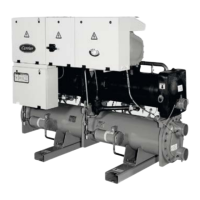38
NOTE: Before this operation we recommend draining the circuit
and disconnecting the pipes to be sure that the bolts are correctly
and uniformly tightened.
9.5.1 - Standard machine
If the chiller or the water piping is in an area where the ambient
temperature can fall below 0°C it is recommended to add an
antifreeze solution to protect the unit and the water piping to a
temperature of 10 K below the lowest temperature likely to be
reached at the installation site. Use only antifreeze solutions,
approved for heat exchanger duty. If the system is not protected
by an antifreeze solution and will not be used during the freezing
weather conditions, draining of the cooler and outdoor piping is
mandatory. Damage due to freezing is not covered by the warranty.
IMPORTANT: Depending on the climatic conditions in your area
you must:
•
Add ethylene glycol with an adequate concentration to protect
the installation up to a temperature of 10 K below the lowest
temperature likely to occur at the installation site.
• If the unit is not used for an extended period, it is
recommended to drain it, and as a safety precaution add
ethylene glycol to the heat exchanger, using the water
entering purge valve connection (a purge connection is
available somewhere on the heat exchanger water box in
case the machine is not perfectly level).
At the start of the next season, rell the unit with water
and add an inhibitor.
• For the installation of auxiliary equipment, the installer
must comply with basic regulations, especially for minimum
and maximum ow rates, which must be between the values
listed in the operating limit table (application data).
9.5.2 - Brine machine
30HXC brine applications below 0°C leaving brine temperature
are not compatible with stopped situations where water ow is
maintained in the evaporator and stopped in the condenser.
The water ow in the evaporator should preferably be stopped
after unit shut down. If this is not possible, then the ow must be
maintained in the condenser too.
In all cases, it is recommended to maintain the water ow in the
condenser few moments after the evaporator ow stopped to allow
safe pressure equilibrium.
Special attention has to be given to the hydraulic design when
option 152 is selected, in order to maintain the condenser ow
even when the 0-10V signal asks for no-ow.
The control of a master/slave assembly is in the entering water
and does not require any additional sensors (standard conguration).
It can also be located in the leaving water. In this case two
additional sensors must be added on the common piping.
All parameters, required for the master/slave function must be
congured using the Service Conguration menu. All remote
controls of the master/slave assembly (start/stop, setpoint, load
shedding etc.) are controlled by the unit congured as master and
must only be applied to the master unit.
Each unit controls its own water pump. If there is only one
common pump, in cases with variable ow, isolation valves must
be installed on each unit. They will be activated at the opening
and closing by the control of each heat pump (in this case the
valves are controlled using the dedicated water pump outputs). See
the 30GX/HXC Pro-Dialog Plus Control IOM for a more detailed
explanation.
9.3.2 - Condenser water ow switch (30HXC)
The use of a condenser water ow switch is recommended. The
ow switch is not supplied, and must be installed on site and
connected in accordance with the wiring diagrams.
The condenser water ow rate must be set to 10 l/s.
The evaporator (and condenser) are of the shell and tube type
with removable water boxes to facilitate cleaning. Re-tightening
or tightening must be done in accordance with the illustration
below.
1 Sequence 1: 1 2 3 4
Sequence2:5678
Sequence3:9101112
2 Tightening torque
BoltsizeM16-171-210Nm

